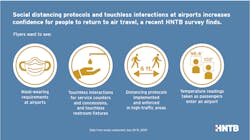Social Distancing and “No Touch” Interactions Key to Rebuilding Confidence in Air Travel
With airlines and airports reporting unprecedented drops in traffic since the COVID-19 pandemic began, travelers who used to fly regularly are sharing what concerns they have about the risks of coronavirus at airports, and on airplanes and what actions can be taken to mitigate their apprehensions.
The HNTB America THINKS survey “Regular Fliers Confidence Study” confirms national data, with only 40% of regular fliers, those who fly at least three times a year for business and/or leisure, reporting they have boarded a plane for a trip since nationwide lockdowns began in March. 64% of those flying report taking a trip for business, while 47% report flying for leisure.
The vast majority of regular flyers who have not taken to the skies cite having “nowhere to go,” with business meetings and conferences cancelled and vacations postponed, as well as discomfort with being in an airport (64%) or in an aircraft (67%).
Chief concerns for travelers about airports are crowded areas and situations that may increase the risk of catching and spreading the virus. The top three areas of concern about airports according to regular flyers surveyed are security screening checkpoint areas (36%), airport trains and shuttles that move passengers within the airport (33%), and the aircraft boarding process (27%). Travelers are least concerned with moving walkways, escalators and elevators, stores and concessions and walking in the concourse.
Travelers express similar concerns about the virus on aircraft. The top three areas of concern about aircraft include sitting next to or near other passengers (60%), followed by recirculated air in the aircraft (42%) and passengers rising simultaneously to deplane (38%). They are least concerned about using food trays, food and beverages served on the aircraft and using the overhead storage bins.
“The study adds to a growing collection of important, industry-wide data that airports, airlines and their partners can use to alleviate customer concerns, restore confidence and rebuild business,” said Lou Russo, aviation market sector leader for HNTB Corporation. “Air travel faces an extraordinary challenge, but one that can be met with collaboration, innovation and determination to adapt to present realities.”
According to 82% of regular flyers, protocols at the airport related to social distancing throughout the experience, from security screening to boarding, would have the greatest positive impact on their level of comfort with flying. 58% also cite they would feel safer with “no touch” interactions, such as touchless restroom fixtures and service counter operations, and airport-wide policies that mandate mask wearing.
Similarly, 80% of regular flyers feel that protocols related to social distancing, such as leaving middle seats empty and rethinking boarding and deplaning procedures, would make them feel safer on airplanes. Mask-wearing requirements and free personal protection supplies, such as hand sanitizer, also can increase passenger comfort levels.
Interviewing for the study was conducted by Russell Research via an online methodology. A total of 1,014 interviews were completed on a national basis for the study. The margin of error is +/- 3.1%. In order to qualify for inclusion in the study respondents were screened to meet the following qualifications:
- Age 18 or older
- Fly three or more times for business or leisure/vacation purposes during a “normal” year
- Security/Compliance questions
